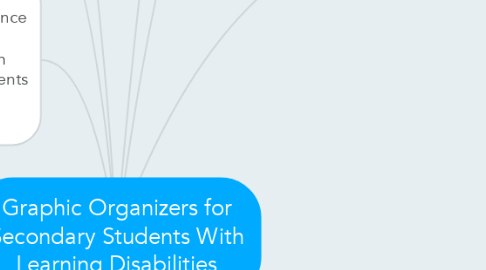
1. Graphic organizers can be used to present information needed prior to reading or to help students remember important information during reading in order to improve comprehension.
2. Students with learning disabilities exhibit difficulties in processing and organizing written and oral information, drawing conclusions, comprehending relationships and connections, distinguishing main ideas from irrelevant information, and understanding the substance of a passage.
3. When using graphic organizers in a lesson, teachers should use an advance organizer, review the advance organizer’s purpose, define the main concept or theme, and involve students by asking questions and eliciting responses (Hughes et al., 2003).
4. Engaging independently in critical reading.
4.1. The IRA-CCSSC (2012) emphasized the importance of students engaging independently in attentive reading so they are able to engage independently in critical reading tasks.
4.1.1. Venn Diagrams
4.1.1.1. Assists in making comparisons between the relationship and differences between concepts using two or more overlapping circles.
4.1.2. Series-of-Events Chain:
4.1.2.1. Used to show the sequence of events in a passage, showing the continuous movement of events.
4.1.3. Concept Map
4.1.3.1. Helps the user make connections between concepts and serves as a brainstorming tool to help organize ideas and enhance memory.
5. Determining what a text says explicitly.
5.1. The IRA-CCSSC (2012) noted that students who learn to engage in close and careful reading in order to determine what a text says explicitly are successful in attentive reading
5.1.1. Story Map
5.1.1.1. Helps visually display crucial information while guiding students’ attention to significant components of the story
5.1.2. Spider Map
5.1.2.1. A spider map relates information to a main idea or theme that does not fit into a hierarchy
5.1.3. Network tree map
5.1.3.1. Starts with the main idea at the top, with subtopics underneath arranged by facts in a content area. It is used to illustrate the influence of each event that took place
5.1.4. Fishbone maps
5.1.4.1. Show the interaction and relationship of a complex event and the resulting effects
6. Evidence of one’s own arguments, presentations, and claims.
6.1. The IRA-CCSSC (2012) proposed that in order to demonstrate understanding from the text through attentive reading, students are challenged to use the information from the text as evidence of one’s own argument, presentation, and claim. Essentially, students must be able to make assertions from the text in order to show a deeper understanding.
6.1.1. Problem Solution Map
6.1.1.1. Help depict information that contains cause-and- effect problems and solutions
6.1.2. Sequential Episodic Map
6.1.2.1. Are helpful in mapping cause and effect. They are useful in displaying information in a sequence and keeping information in proper order.
